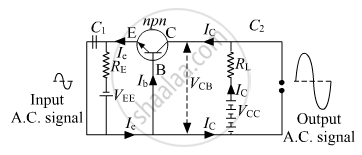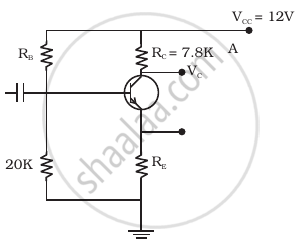Advertisements
Advertisements
Question
Draw a circuit diagram of an n-p-n transistor with its emitter-base junction forward biased and base-collector junction reverse biased. Briefly describe its working.
Explain how a transistor in its active state exhibits a low resistance at its emitter-base junction and high resistance at its base-collector junction.
Solution
an n-p-n transistor with an emitter-base junction is forward biased and base-collector junction reverses biased:

Working: The figure shows the emitter-base junction is forward biased and the collector-base junction is reversed biased. When the input signal voltage is fed to the emitter-base current, it changes the emitter-base voltage and hence the emitter current. Which in turn changes the collector current. Due to it, the collector voltage VCB varies in accordance with the relation VCB =VCC - ICRL. This variation in collector voltage appears as an amplified output(Vo)
For an n-p-n transistor in the active state, resistance is kept low at the emitter-base junction and high at the base-collector junction because the n-p-n transistor is used to amplify the low voltage input to a high voltage out. As the input is applied at the emitter-base junction hence for a low input voltage the resistance at the emitter-base junction is kept low, and the output is obtained at base-collector, so for high voltage output, resistance is kept low at the base-collector junction.
APPEARS IN
RELATED QUESTIONS
Draw a simple circuit of a CE transistor amplifier. Explain its working ?
Show that the voltage gain, AV, of the amplifier is given by `A_v = (beta_(ac) R_1)/r_i`where βac is the current gain, RL is the load resistance and ri is the input resistance of the transistor. What is the significance of the negative sign in the expression for the voltage gain?
Let iE, iC and iB represent the emitter current, the collector current and the base current respectively in a transistor. Then
(a) iC is slightly smaller than iE
(b) iC is slightly greater than iE
(c) iB is much smaller than iE
(d) iB is much greater than iE.
In a normal operation of a transistor,
(a) the base−emitter junction is forward-baised
(b) the base−collector junction is forward-baised
(c) the base−emitter junction is reverse-baised
(d) the base−collector junction is reverse-baised.
Draw a circuit diagram of an n-p-n transistor with its emitter-base junction forward biased and basecollector junction reverse biased. Briefly describe its working.
Explain how a transistor in its active state exhibits a low resistance at its emitter-base junction and high resistance at its base-collector junction.
Derive the expression for the voltage gain of a transistor amplifier in CE configuration in terms of the load resistance RL, current gain a βa and input resistance.
Explain why input and output voltages are in opposite phase.
Derive the expression for the voltage gain of a transistor amplifier in CE configuration in terms of the load resistance RL, current gain βa and input resistance.
Explain why input and output voltages are in the opposite phase.
Answer the following question.
Draw the circuit arrangement for studying the output characteristics of an n-p-n transistor in CE configuration. Explain how the output characteristics is obtained.
For the transistor circuit shown in figure, evaluate VE, RB, RE given IC = 1 mA, VCE = 3 V, VBE = 0.5 V and VCC = 12 V, β = 100.

